

On March 17, 2002, two small satellites (nicknamed Tom and Jerry) blasted off from the Plesetsk Cosmodrome in northern Russia. In the 15 years since, there is nothing funny about what this pair has accomplished. In fact, as my colleague Carol Rasmussen noted, revolutionary is more often the word used when scientists describe the Gravity Recovery and Climate Experiment (GRACE).
By measuring Earth’s gravity field, the satellites have pioneered a whole new way of monitoring water. The details of what this pair has observed has been eye-opening. Among the most sobering of GRACE’s many discoveries:
In cat years, Tom and Jerry are nearing 75. To celebrate their longevity, give a read of this excellent overview story written by Holli Riebeek of the Earth Observatory and this list of all the GRACE press announcements from the Jet Propulsion Laboratory. Below are a few of my favorite videos and data visualizations about the mission.
The American Museum of Natural History video offers a quick overview. The State Department video is longer and wonkier, but has some really interesting details. And the 60 Minutes clip (part of this longer episode) is a reminder that NASA studies earth science in a way that few other organizations can. Click on each of the maps below to find out more about them.
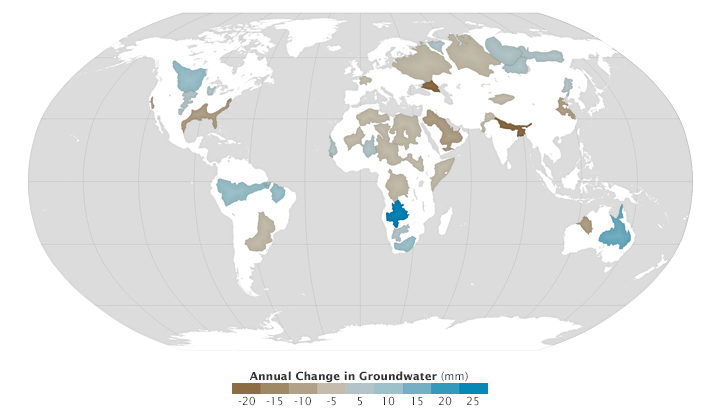
NASA Earth Observatory images by Joshua Stevens using GRACE global groundwater data courtesy of Jay Famiglietti NASA JPL/University of California Irvine and Richey et al. (2015).
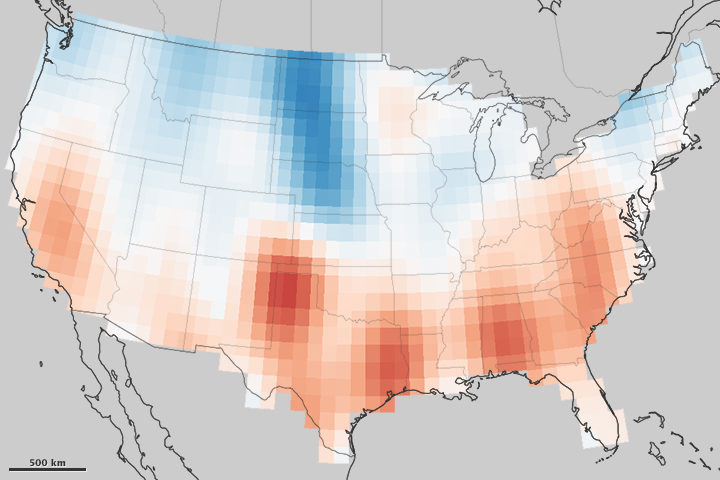
NASA Earth Observatory image by Jesse Allen, using GRACE data provide courtesy of Jay Famigleitti, University of California Irvine and Matthew Rodell, NASA GSFC, and Famiglietti & Rodell (2013).
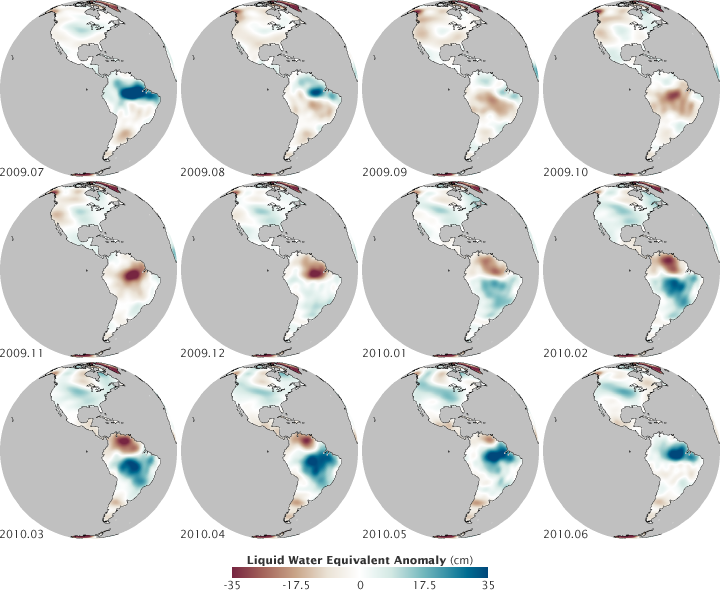
NASA maps by Robert Simmon, using GRACE data.
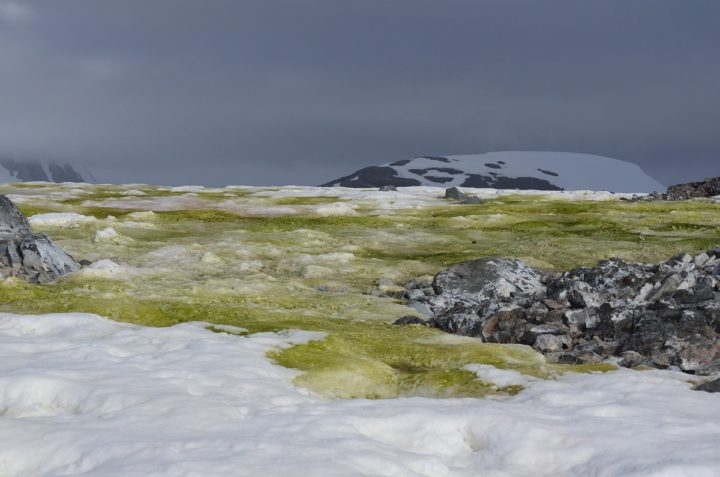
You never know where phytoplankton will turn up next. From space, we regularly see colorful blooms of them swirling in the world’s oceans. Inland basins and waterways support them too, such as Florida’s Lake Okeechobee, Washington’s Hood Canal, and North America’s Great Lakes.
Even the waters off the coast of Antarctica can sustain blooms. We recently showed a satellite image in which algae in a harbor near the Ross Sea had turned the sea ice a wild shade of green. As this photograph shows, they also appear to thrive on the snow and ice capping the southern continent.
“I was in Antarctica in February 2013 and saw plenty of algae happily growing in the ice (green, yellow, and red),” said ocean scientist Norman Kuring of NASA’s Goddard Space Flight Center. “I took this photo on Orne Island showing lots of green snow and ice.”
Kuring notes, however, that the type of phytoplankton inhabiting the snow and ice on Orne Island — on the opposite side of the continent, near the Antarctic Peninsula — is probably different from the species that bloomed in the Ross Sea. Direct sampling and analysis is the best way to know for sure, but that’s not always possible, especially in remote regions.
Editor’s note: Here’s a roundup of the latest eye-catching earth science videos from NASA and beyond. In March, snow emerged as a theme.
Where there is snow, there is water. Scientists trudged through thick white powder in Grand Mesa and the Senator Beck Basin to measure the depth of snow — and its water content — for the SnowEx campaign.
SIX SIDES AND A WHOLE LOT O’ COOL
A scientist with the Global Precipitation Measurement (GPM) mission explains why snowflakes look the way they do.
SIX THINGS YOU DON’T KNOW ABOUT SNOW
Did you know that 60 million Americans rely on snowmelt as their main source of water?
And if you’re not completely buried in white stuff, check out a National Geographic short documentary on a Colorado man who has been taking daily snow measurements for decades.
JUMPING TO LIGHT SPEED IN THE PURSUIT OF SNOW
“Photon Jump” tells the story of an exuberant photon. Follow this miniature light particle as s/he is spat out of a satellite sensor in Earth’s orbit. A team of students at Georgia’s Savannah College of Art and Design (SCAD) created the film for the upcoming ICESat-2 mission, which will measure snow and ice on Earth.
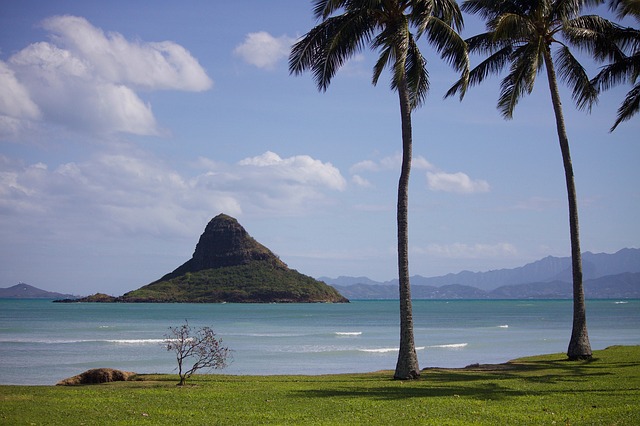
In Hawaii, land of palm trees, pineapples, and year-round surfing, a full-blown blizzard hit last week. The early March storm brought more than 8 inches (20 centimeters) to the top of Mauna Kea volcano, leading authorities to shut the road to the peak.
The snow was all the more surprising given how little has fallen in more traditionally snowy locales. Hawaii received more snow that day than Denver has accumulated over the past seven weeks. The Colorado city got 1.6 inches (4 centimeters) in the past 51 days, according to local news.
The island archipelago also got more white stuff than Chicago. That city, famed for its bitter winters, is currently in the midst of a snow drought, with a mere 0.6 inches (1.5 centimeters) falling in 2017. That’s the least on record since the late 1800s. To put that into perspective: Chicago averages 37 inches (94 cm) of yearly snowfall. By contrast, Hawaii gets a yearly average of 3.7 inches (9 cm).
Thanks to their height, the peaks of Mauna Kea and Mauna Loa volcanoes do receive a dusting now and again. But that snow rarely sticks around for more than a few days, according to Ken Rubin, an assistant professor of geology and geophysics at the University of Hawaii.

Mauna Kea in December 2016. Image: NASA Earth Observatory/Jesse Allen, using Landsat data from the U.S. Geological Survey.
If you’re like me, you’ll find yourself transfixed by this newly released clip of lightning flashes flitting across Texas skies at night. These data were captured by the Geostationary Lightning Mapper (GLM), a first-of-its-kind sensor that was launched into space on GOES-16 (called GOES-R prior to launch) in November 2016. The sensor makes continuous observations of lightning flashes—a new capability that should markedly improve weather forecasts of severe thunderstorms and tornadoes.
The video clip—an animation of GLM observations overlaid on Advanced Baseline Imager (ABI) cloud imagery—shows lightning flashing over southeast Texas on the morning of February 14, 2017. As explained by NOAA’s Michelle Smith, the green cross indicates the location of Houston, and the green dotted lines show the Texas coastline. Rendered at 25 frames per second, the animation simulates what your eye might see if it was above the clouds. GLM observes the scene at 500 frames per second, and can distinguish the location, intensity, and horizontal propagation of individual strokes within each lightning flash.

Every month on Earth Matters, we offer a puzzling satellite image. The March 2017 puzzler is above. Your challenge is to use the comments section to tell us what part of the world we are looking at, when the image was acquired, what the image shows, and why the scene is interesting.
How to answer. Your answer can be a few words or several paragraphs. (Try to keep it shorter than 200 words). You might simply tell us what part of the world an image shows. Or you can dig deeper and explain what satellite and instrument produced the image, what spectral bands were used to create it, or what is compelling about some obscure speck in the far corner of an image. If you think something is interesting or noteworthy, tell us about it.
The prize. We can’t offer prize money or a trip to Mars, but we can promise you credit and glory. Well, maybe just credit. Roughly one week after a puzzler image appears on this blog, we will post an annotated and captioned version as our Image of the Day. After we post the answer, we will acknowledge the person who was first to correctly ID the image at the bottom of this blog post. We may also recognize certain readers who offer the most interesting tidbits of information about the geological, meteorological, or human processes that have played a role in molding the landscape. Please include your preferred name or alias with your comment. If you work for or attend an institution that you want us to recognize, please mention that as well.
Recent winners. If you’ve won the puzzler in the last few months or work in geospatial imaging, please sit on your hands for at least a day to give others a chance to play.
Releasing Comments. Savvy readers have solved some of our puzzlers after only a few minutes or hours. To give more people a chance to play, we may wait between 24-48 hours before posting the answers we receive in the comment thread.
Good luck!
Editor’s Note: Congratulations to Italo Moletto-Lobos, Mark D, Peter Upshall, and Avinash Wagh for being the first readers to solve the puzzler on Earth Matters and Facebook. Special mention goes to Mark D and James Varghese for their thorough explanations. See a labeled version of the March puzzler with a detailed description of central-pivot irrigation in Egypt’s Western Desert here.
Regular readers of our site may have noticed our recent piece on the Antarctic Peninsula. That Aqua MODIS shot was made possible by a weather pattern that brings clearer skies to the peninsula in January or February most years. You can see the same pattern in finer detail with a mosaic of Landsat scenes from early 2016.
But that was last year: what are things like this year?
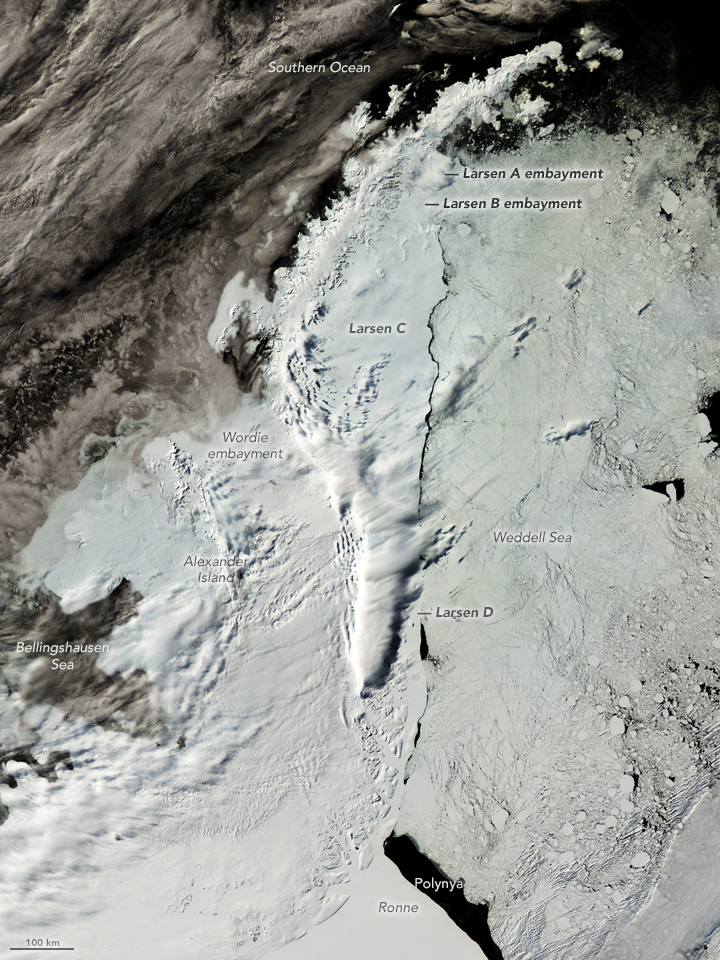
Here’s the best shot of the peninsula this year during the “clear skies” season. It comes from the Aqua MODIS instrument and was acquired on February 7, 2017.
You can quickly see that it is not as clear as the best view from early 2016. The western side of the Peninsula and its neighboring islands are clouded in. On the other side, there’s a clearer edge to the eastern ice shelves because the wind has been blowing the loose sea ice in the Weddell Sea away from the coast, leaving a narrow gap of open water along the edges of the shelves. The distinction between the Larsen C and D shelves and the sea ice is much more clear than it was last year.
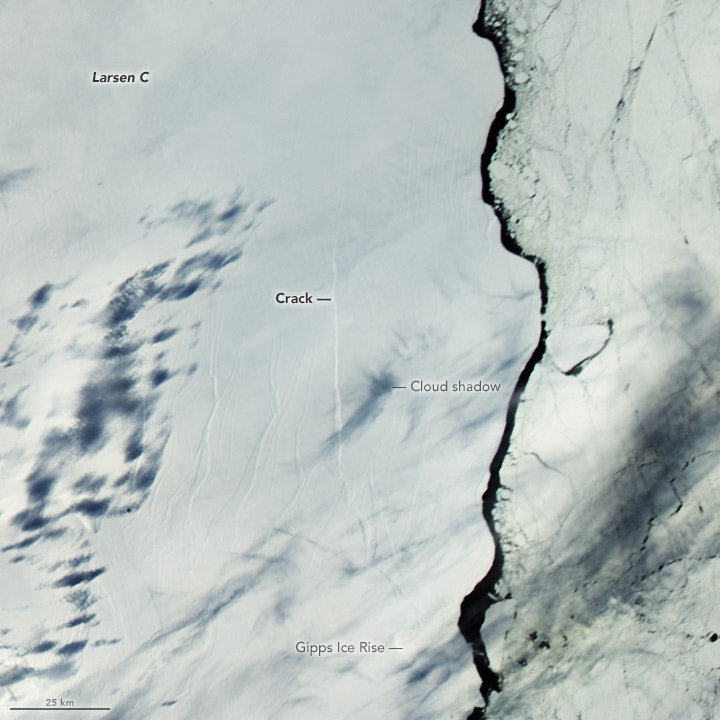
In a closer view, you can also see the crack in the Larsen C ice shelf. In August 2016, the crack extended from the Gipps Ice Rise northward for 130 kilometers (80 miles), and the crack has continued to grow since.

Credit: NASA Earth Observatory/VIIRS/Jesse Allen. More details about the image here.
In the past two months, weather reports in California, Oregon, and Washington have been filled with news of “atmospheric rivers” bringing copious amounts of rain and snow to the western United States. Atmospheric rivers are long, thin fingers of moisture that develop in the tropics and flow into higher latitudes. If one of them makes landfall, huge of amounts of rain and snow can fall in a short period.
Much of this moisture, of course, eventually finds its way back to the sea through rivers. When waterways are swollen and flowing rapidly, they also become rivers of suspended sediment, full of clay, mud, sand, and other debris. Though the flooding from atmospheric river events can be devastating, the enormous amount of sediment they send rushing into the sea can also be surprisingly beautiful.
For instance, on February 11, 2017, the Visible Infrared Imaging Radiometer Suite (VIIRS) on Suomi NPP acquired this remarkable view of rivers and streams spewing sediment into the Pacific Ocean. Close to the outlets of streams and rivers, sediment-rich waters appear brown. As the sediment dissipates and mixes into the ocean, the water appears teal.
Duane Waliser, a scientist at NASA’s Jet Propulsion Laboratory, recently tallied just how damaging atmospheric rivers can be for coastal areas. In a study published in Nature Geoscience, Waliser and a colleague showed that atmospheric rivers are among the most damaging storm types in the middle latitudes. Of the very wettest and windiest storms (those ranked in the top 2 percent), atmospheric rivers were associated with nearly half of them. Waliser and colleagues also found that atmospheric rivers were associated with a doubling of the typical wind speed compared to all storm conditions.

Image originally published by NOAA.

Image Credit: NASA Earth Observatory/Joshua Stevens
In celebration of Valentine’s Day, the NASA Earth Observatory staff took some time to look through our archives to find a few images that we absolutely love. You will find eight of our favorite scenes below: the islands of Mergui Archipelago, tea-colored water in James Bay, a snowy scene of Long Island, the intricate waterways of Musa Bay, an eddy of phytoplankton near South Africa, the Nardo racing ring in Italy, sea ice and icebergs in Antarctica, and a meandering river in the Amazon. Each staff member wrote a short note explaining why they chose the image.
Do you have a crush on NASA, earth science, and satellite imagery like we do? Get in on the fun by finding your favorite image from our archives and posting the link to the comment thread (and your social media sites of choice) with a few words explaining why you love the image. If you have trouble finding the perfect match by blindly searching our archives, you can also go to this page and sort by category, year, and month. You can also try our Visible Earth archive, where the images are conveniently categorized by what they show and which satellite sensor acquired them.

Image credit: NASA Earth Observatory/Landsat 5/TM. More details here.
This image is full of fantastic reminders about our planet and the science of Earth observation. Sediment flows, forests, and human settlement can all be seen in gorgeous color. But what’s more — the image was acquired by Landsat 5 back in 2004. We are currently two generations further in the Landsat constellation; this image is a vivid reminder of the quality and depth of that legacy. — Joshua Stevens, data visualizer

Image credit: NASA Earth Observatory/Landsat 8/OLI. More details here.
If you’ve ever read the blog FYFD or even spent time looking carefully at cream swirling around in your coffee, you’ll know why I love this image. There are times that fluids just going about their mundane business of mixing and flowing make patterns that are insanely beautiful. Check out our original story for a more detailed view of the von Kármán vortices swirling away from the small island in the middle of the Bay to see what I mean. — Adam Voiland, science writer

Image credit: NASA Earth Observatory/Landsat 8/OLI. More info here.
Home is where the heart lies. In my case, that’s New York City and Long Island — my two homes. I grew up in both of these places, and love them both. This image shows dense snow that covered New York in February 2015. If Landsat 8’s Operational Land Imager (OLI) could zoom in farther, you might see my mom and me cross-country skiing on the beach, or my dog bounding through the hills of snow. I still remember the enormous ice floes in Long Island Sound, which you can see in this image. — Pola Lem, science writer

Image Credit: NASA Earth Observtory/EO-1/ALI. More info here.
There’s a lot to this image I really like. The dendritic pattern of waterways and the sharp contrast that has against the strong straight linear features of man-made structures is quite striking. Also, the way that the warm, reddish-browns and the cool-toned blues and greens weave together is really compelling. Finally, I like the backstory of how we found this image: it was an accidental discovery made possible only because the satellite — Earth Observing-1 — produces a small number of images each day, making reading the entire list of images acquired (not just known objects of interest) possible for serendipitous discoveries like this. — Jesse Allen, data visualizer

Image credit: NASA Earth Observatory/Terra/MODIS. More info here.
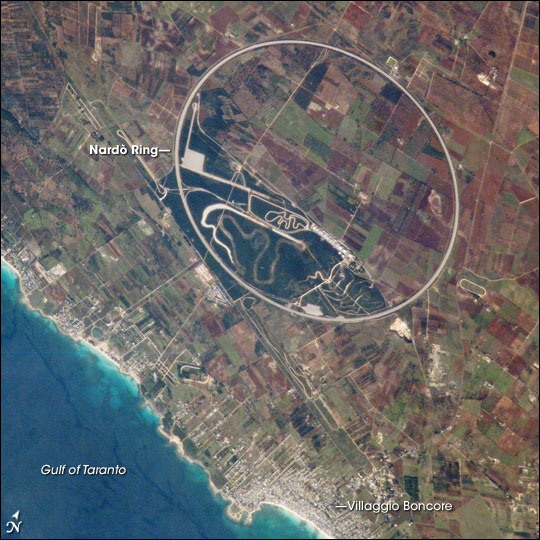
Image credit: NASA/International Space Station/Expedition 14. More info here.
Being an automotive enthusiast, as well as an amateur racer, I’ve always loved images of the Nardo Ring. This racing circuit is a perfect circle, and massive in order to be used for vehicle testing. Highways, city girds, and other roadways are often prominent features in astronaut photography, but the scale and precision of the Nardo Ring are impressive when set against the Italian farm fields. It’s easy to see, even from up there, the impact the racing and automotive culture has on Italy, and the rest of the world. — Paul Przyborski, programmer/dba/designer

Image credit: NASA Earth Observatory/EO-1/ALI. More info here.
I really like this image because of the variety of blue and white hues. There is young ice, old ice, icebergs that are trapped in sea ice, and all of it is accentuated by an oblique sun angle casting shadows and highlighting texture. — Kevin Ward, team leader

Image Credit: NASA Earth Observatory/Landsat 8/OLI. More info here.
If I’m not mountain biking, you will probably find me kayaking—a hobby partly inspired by regularly seeing incredible views of Earth’s rivers from space at work. What I love most about this image of Rio Mamoré in the Amazon Basin is how you can see how much the rivers meander and migrate over time. Interestingly, researchers studying rivers in this region found that the greater the amount of sediment from external sources (glacial, volcanic, or human activity), the more likely the rivers were to meander. — Kathryn Hansen, science writer

NASA Earth Observatory images by Joshua Stevens, using VIIRS data from the Suomi National Polar-orbiting Partnership and the Fire Information for Resource Management System (FIRMS). The map shows fires detected on November 2, 2016.
When I was writing about the crop fires in northern India last fall, it was obvious that 2016 was a pretty severe burning season. For several weeks, large plumes of smoke from Punjab and Haryana blotted out towns and cities along the Indo-Gangetic plain in satellite images.
But I didn’t realize just how severe the fires were until Hiren Jethva, an atmospheric scientist at NASA Goddard Space Flight Center, crunched the numbers. By analyzing satellite records of fire activity, he found that the 2016 fires were the most severe the region has seen since 2002 in regards to the number of fire hot spots satellites detected. In regards to the amount of smoke detected, the 2016 burning was the most severe observed since 2004. He used data from the Moderate Resolution Imaging Spectroradiometer (MODIS) sensor on Aqua and the Ozone Monitoring Instrument (OMI) on Aura to reach his conclusions.
Smoke and fire in northern India have become common in October and November during the last three decades because farmers increasingly use combines to harvest rice and wheat. Since these machines leave stems and other plant residue behind, farmers have started to use fire to clear the leftover debris away in preparation for the next planting.
For more details about how 2016 compared to past years, see the charts below, which Jethva prepared. His explanation for each chart is in italics.
Aqua Detected More Fires in 2016 Than During Any Year Since 2002

Chart by Hiren Jethva based on MODIS data.
The satellite-based sensor MODIS can detect the signal of fire hot spots, also called thermal anomalies, because the signal measured by the sensor in space in the thermal infrared bands appears to be an anomaly compared to the signal emanated from the background land. Since its launch in 2002, the MODIS on NASA’s Aqua satellite has detected thermal anomalies such as wildfires, agricultural fires, and gas flares on a daily basis.
The yearly evolution of total number of fires and Fire Radiative Power (FRP) — the heat energy produced from these fires — detected over Punjab and Haryana showed 2016 to be an anomalous year, with the highest number of crop residue fires (18,707) and the highest FRP in relation to the fires in all other years over the region. In comparison to 2015, the total number of fire hot spots detected over the region in 2016 was 43 percent higher; the difference is 25 percent if the hot spot counts are averaged over the last five years, i.e., 2011-2015. A careful look at the time-evolution of fire counts also reveals an increasing trend in the total number of fires over the region.
Punjab Skies Were Unusually Smoky

Chart by Hiren Jethva based on OMI data.
These fires produced huge amounts of fine aerosol particles and trace gases, which can potentially impact the climate and degrade air quality drastically at ground level. NASA’s A-train sensors such as the Ozone Monitoring Instrument (OMI) on the Aura satellite and the MODIS on Aqua offer capabilities to measure the total amounts of airborne particles. The UV Aerosol Index (UV-AI), which is an excellent indicator of the column amounts of light-absorbing particles in clear as well as cloudy atmospheres, showed 2016 was the smokiest season on record since 2004.
Greener Fields and Larger Harvests Lead to More Fires

Many studies have shown that satellite measurements of the “greenness” of crop fields prior to harvest and crop yield after the harvest are strongly correlated. The normalized difference vegetation index (NDVI), which is derived from satellite measurements of radiation at the red and near-infrared light, is one useful measure of greenness. As seen in the charts above, there seems to be a one-to-one relationship in NDVI measured by the MODIS sensor on Aqua prior to harvest (September) and the total number of fire hot spots observed during harvest season (Oct-Nov). This suggest that the increase in the number of fires is likely related to increasing crop yields.